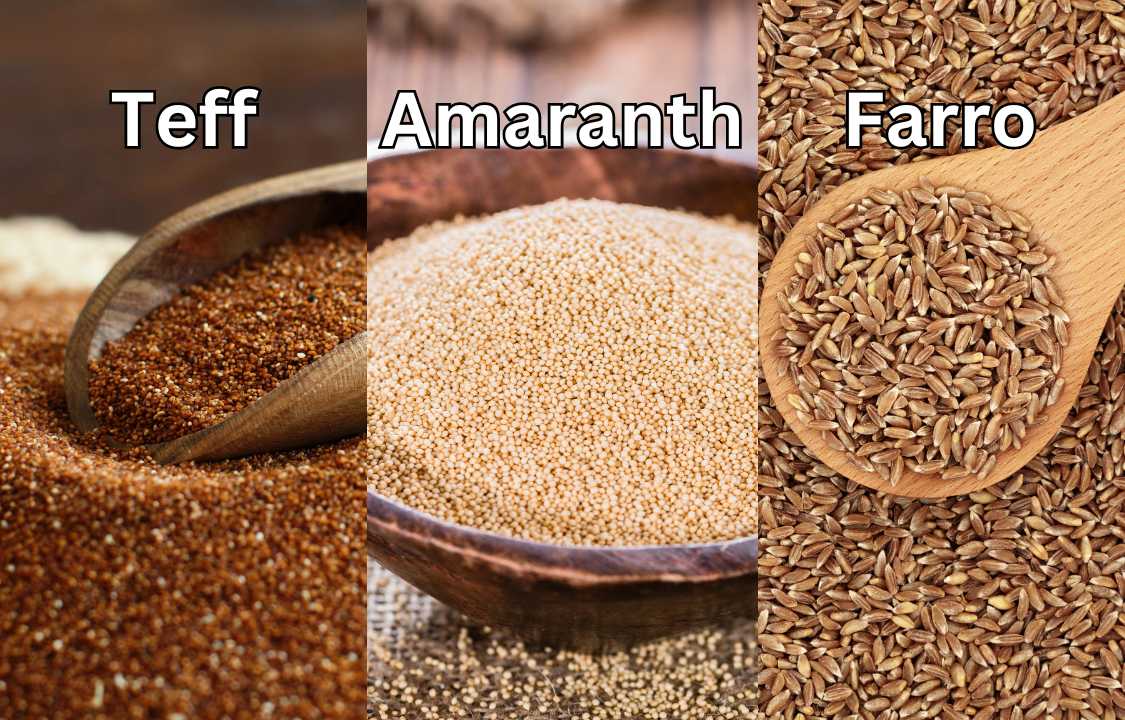Health Benefits
Venturing Beyond the Usual: A Culinary Journey through Teff, Amaranth, and Farro
Grains are the cornerstone of our diets, having been cherished sustenance since time immemorial. Although many are accustomed to the familiar trio of rice, wheat, and corn, there’s a treasure trove of ancient and obscure grains waiting to be rediscovered. The spotlight here is on teff, amaranth, and farro, each with its unique narrative and nutritive bounty.
Teff: A Glimpse into Ethiopia’s Edible Heritage

From the Heart of Africa: Born in Ethiopia and Eritrea, teff holds a cherished spot in the local culinary tapestry, most famously morphing into the sourdough flatbread, injera.
Nutritive Goldmine:
- Protein-rich: A bite of teff delivers all nine essential amino acids, making it a compact protein powerhouse.
- Mineral Marvel: It’s a rich reserve of calcium, iron, and magnesium.
- Gluten-Free Goodness: A boon for the gluten-sensitive and celiac community.
- Fiber Frontier: Rich in resistant starch, teff is a friend to your gut, aiding in digestion.
Amaranth: The Aztec Legacy

New World Wonder: Tracing back to the Aztecs, amaranth, a pseudocereal from the Americas, mirrors a grain in its culinary uses, despite its botanical differences.
Nutritional Nirvana:
- Protein-packed: It outshines many grains with its protein content and gifts us with lysine, a rare plant-based essential amino acid.
- Micronutrient Magnate: It’s laden with vital minerals including magnesium, iron, selenium, and zinc.
- Antioxidant Aplenty: Its repertoire of phenolic compounds, flavonoids, and squalene underscore its antioxidant prowess.
- Gluten-Free Gala: Another worthy candidate for the gluten-free brigade.
Farro: The Old World Grain

Fertile Crescent Foster: With roots deep in the ancient lands of the Fertile Crescent, farro has been a cherished harvest in Italy for eons.
Nutritional Navigator:
- Carb Composure: As a complex carb, farro is a slow-releasing energy dynamo.
- Fiber Fountain: Rich in fiber, it’s a silent worker for your digestive tract and cholesterol management.
- Protein Prominence: It outmuscles common grains like rice and quinoa in the protein domain.
- Micronutrient Muse: A haven of B vitamins, magnesium, and iron.
- Gluten Alert: Unlike its peers here, farro is a gluten host, a caveat for the gluten-sensitive.
Comparative Grain Gaze:
- Nutrient Nobility: These uncelebrated grains, with their higher nutrient density, challenge the nutritional stature of common grains like white rice or refined wheat.
- Culinary Carnival: They offer a carousel of textures and flavors, breathing new life into the culinary canvas.
- Eco-Efficient Edibles: These grains often excel in harmonizing with their local ecosystems, demanding less water or fertilizers, thus paving a path towards sustainable farming.
- Gluten Gauge: While teff and amaranth extend a gluten-free invite, farro calls for caution for those treading the gluten-free trail.
Concluding Reflections
While the conventional grains continue to grace our plates, delving into the diverse granary of teff, amaranth, and farro can be both a culinary and nutritional expedition. Engaging with these grains not only broadens the dietary horizon but also kindles a historical and cultural discourse, uniting ancient civilizations with modern-day meal tables. Moreover, it’s a step towards fostering sustainable food practices, a requisite in our current global narrative.
Supplemental Wisdom
The narrative of food is the narrative of humanity. Each grain, often tucked away in the annals of culinary history, carries with it tales of civilizations, their struggles, and their triumphs. By reintegrating these ancient grains into our modern-day diets, we’re not just nourishing our bodies, but we’re also revisiting the rich tapestry of our collective human heritage. Moreover, these grains, resilient and eco-friendly, could be instrumental in addressing some of the contemporary challenges of food security and sustainability, making our food narrative not just rich, but also forward-looking.

